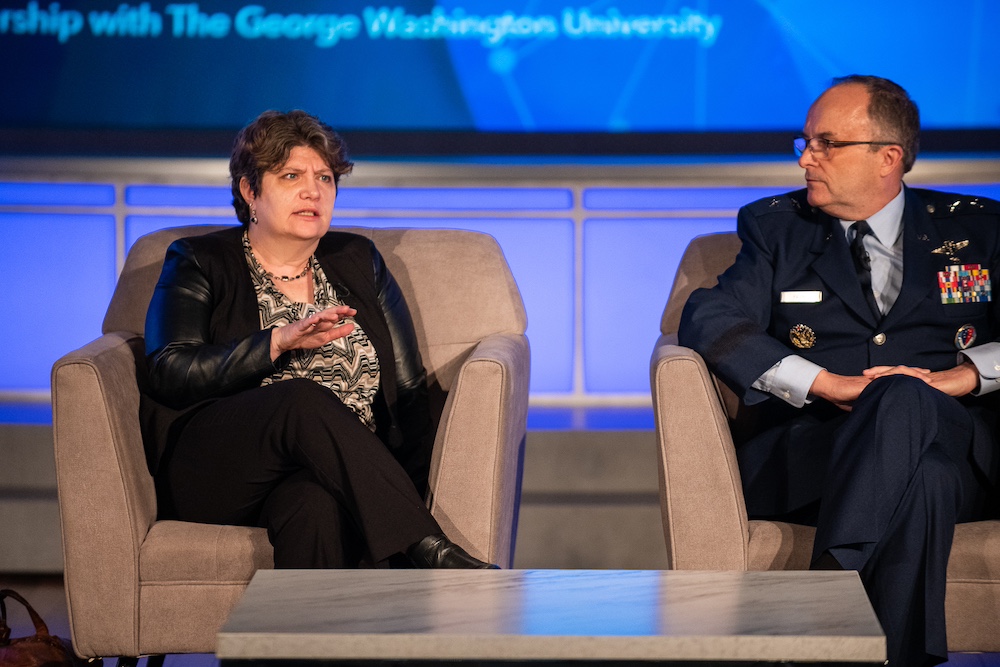GSA Deputy CIO Emphasizes Benefits of Hybrid Cloud, Emerging Tech
Beth Killoran demonstrated the ability to rapidly adapt to unexpected circumstances and customer needs.

Toy rocketships and Legos may have little if anything to do with IT transformation at first glance, but for GSA Deputy CIO Beth Killoran, they are an important illustrative tool.
“Everyone wants to be able to fly and have the ability to soar into space,” Killoran said, presenting a wooden rocket to the audience at the Dell Technologies Forum, likening the rocketship to an antiquated cloud architecture. “But how old is this technology? What if I can’t find a part?”
In the previous week, one of GSA’s cloud environments had two at-capacity drives fail, rendering the system completely “unusable to customers,” and the only solution was to repair the entire system, a process that would take an estimated two weeks. This kind of system does not work in a “hyperconverged world,” she said.
“We have another environment — Legos,” Killoran joked, pulling out a Lego rocketship, which she began to break apart and reconfigure in front of the audience. “I’m going to rapidly figure out how to move this critical acquisition system to my other environment that I can pick up, change and move around — that is my hyperconverged environment. We did it in five hours.”
Were it not for the rapid change to a hybrid cloud, essential acquisition functions would still be at a standstill at GSA.
“We are a federal agency that does not have a data center,” Killoran said. “Let that sink in.”
As an early cloud adopter, GSA has closed 120 data centers, saving the agency approximately $8.5 million annually, she said. For systems that are still on-prem at GSA, she added, GSA is pursuing a hybrid-cloud environment, opting for an enterprise-wide system and some cases and mission-specific environments depending on the capabilities required. It has been especially important to keep this in mind during the height of federal acquisition season.
“How many of you have teams back at the office that are frantically putting out proposals for government work?” she asked. “Think about — on [GSA’s] side — how much data and additional load that is putting on our systems. But do we really want to have that capacity at all times and the cost associated with doing it?” A hybrid cloud, focused around surge capacity and the focus of GSA’s mission, allows GSA to “rapidly change to those environments.”
GSA plans to further modernize and connect its systems through application programming interfaces (APIs), looking at the success of the Department of Veterans Affairs as a model.
“We have three tenets that we’re looking at,” Killoran said. “One, what is the customer experience?” GSA wants to ensure any new tech is multi-functional.
“The second thing,” Killoran enumerated, “is how are we putting together that infrastructure or capability so that it meets not only the needs of today, but is flexible enough — as my Legos showed you — that you can pop pieces in and out … to keep pace.” GSA expects that flexibility will foster technologies that are “efficient and effective in the long term.”
“The third thing,” Killoran said, “is always understanding privacy and security as part of that and understanding the culture in which you’re implementing this technology.” GSA will engage stakeholders in API technology to ensure the efficient progress is not halted or reversed due to inadequate security.
Additionally, Killoran’s team is building “foundational building blocks” for the next wave of emerging technology.
“We’ve already exceeded our expectations for RPA,” Killoran said, as the GSA expands its automation platform and looks to transition three or four of its most effective AI and machine-learning pilot programs into “true production.” GSA is also looking at smart building technology to ensure federal employees work in comfortable environments and researching autonomous vehicles.
For other agencies looking at how to best pursue cloud adoption or implement emerging technologies, Killoran offered a few pieces of advice. Changes to the business should be driven by the business, she recommended, rather than adopting new technology for its own sake. She also encouraged agencies to “take risks,” but to do it in “safe havens” where agencies can test new methods and technologies before full adoption.
“It’s the same thing as you think about in science,” Killoran said. “You’re going to have a hypothesis, you’re going to have a potential problem you’re trying to solve, and you’re going to have a solution that you want to test. Depending on the outcome, you may have to do another test or have another theory, but when you get that successful outcome, you can make it expand rapidly.”
This is a carousel with manually rotating slides. Use Next and Previous buttons to navigate or jump to a slide with the slide dots
-

A Prepared Workforce is Key to Cyber Resiliency
Strong training strategies and emphasizing cyber hygiene basics enhance security practices at federal agencies.
2m read -

Strategies for Effective Data Modernization
Data is the lifeblood of critical decisions and streamlines operations across the government, but many agencies struggle with inconsistent standards.
33m watch -

Coast Guard Poised for Growth in Cyber
The service’s prevention policy chief discusses his priorities for combatting cyber incidents that could have global impacts.
23m listen -

CDC Updates Public Health Data Strategy
Accelerating data sharing through capabilities like electronic case reporting make up a large portion of the new two-year plan.
3m read




